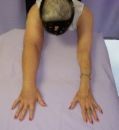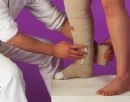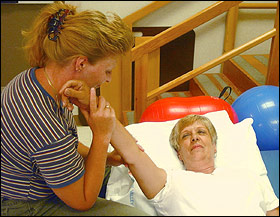Lymphedema…is there help?
Lymphedema is a chronic swelling in a portion of the body (typically an arm/leg) due to an accumulation of lymph fluid (protein & water) in the tissue spaces as a result of lymph node removal and or radiation. 
Surgical and radiation treatments for patients with breast cancer treatments are one of the most common causes of lymphedema. During surgery lymph nodes often need to be removed. Scarring after radiation further compromises the chest wall and axilla which places women at risk for this condition.
It can develop months or years after surgery. Lymphedema can be triggered by infection, injury, repetitive motion, plane flight or develop more gradually. Other factors that can trigger lymphedema in patients that are already at risk include: sudden changes in temperature, trauma, and vigorous massages.
Symptoms of lymphedema may include sensation of ache, fatigue, bursting, swelling, cramping, jewelry not fitting, numbness, & heaviness in the arm or leg. The symptoms can be painful at times. It is best to be alert to the signs of lymphedema so that treatment can begin as soon as possible.
How is lymphedema treated? Complete Decongestive Therapy is the best treatment at present. This program includes manual lymph drainage (where therapists use massage techniques to remove fluid), compression bandages, compression garments, patient specific lymphedema exercises, and skin care.
- Manual lymph drainage is a rhythmic massage performed in a proximal to distal fashion to stimulate the flow of lymph.
- Compression of the limb follows by bandaging the affected limb, which prevents the flow of lymph back to the arm during sleep. The bandages allow for a low resting pressure and high working pressure which encourage lymph flow. Wrapping is done in a spiral manner with more pressure applied distally and less proximally. Mild exercise is used to promote the action of muscle pumps which stimulate the movement of lymph fluid. Muscles squeeze the tissues carrying lymph and help it flow back towards the heart.

- Once the arm size is stabilized over a period of weeks, a compression garment is provided to maintain the arm. This garment should be worn during land exercise and is flexible during exercise and rigid at rest. Consistent pressure is applied throughout the garment rather than more pressure at the forearm and arm as bandages do.
- Modalities that increase vasodilation, ie hot tubs, should be avoided. Be alert to signs of infection which include the following: warmth, redness, pain, skin blotchiness, swelling, temperature, and flu like symptoms. A physician should be contacted immediately.
If you are concerned you may have lymphedema, contact your physician for a referral. If you have any questions, please give us a call.
Odette Shaheen, Physical Therapist Assistant in our Indian River Clinic and Monica Wendt, Physical Therapist in our Cheboygan clinic are our specialties in treating lymphedema management for the upper & lower extremities.







